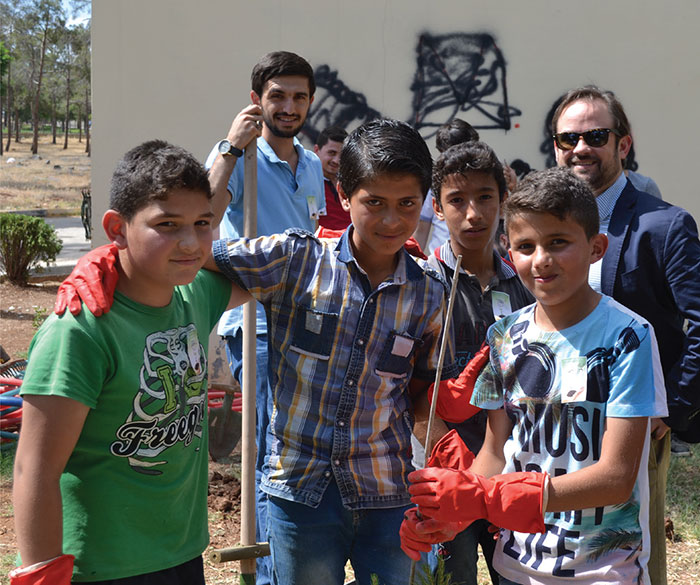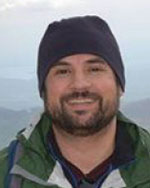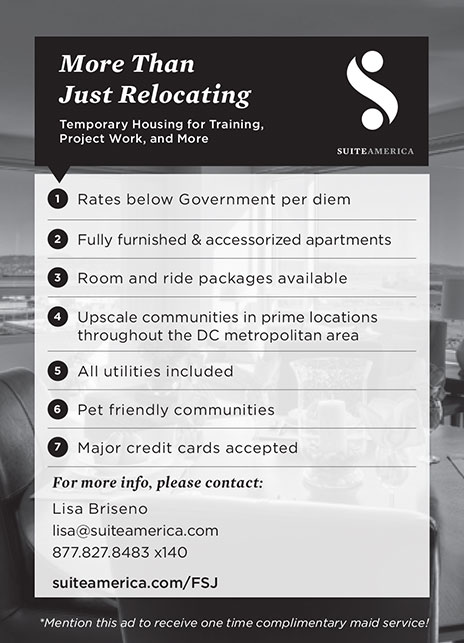On the Ground in Turkey
These notes from the diary of an FSO refugee coordinator in Turkey convey the realities of the humanitarian crisis spreading from the Middle East.
BY MATTHEW R. JOHNSON

Leaving the familiar and comfortable confines of Madrid and Western Europe behind me, I arrived in Turkey in mid-September 2014 as the first refugee coordinator sent there by the State Department’s Bureau of Population, Refugees and Migration. I landed in the evening, checked in (partially) at the consulate in Adana the next day and immediately set off on a five-day whirlwind trip to Istanbul, Gaziantep and Antakya (Antioch) in support of a visit by PRM's principal deputy assistant secretary.
Arriving back in Adana, I thought I would have a chance to breathe and do some of the mundane things we take for granted: unpack, buy groceries, familiarize myself with my new home. Instead, the so-called Islamic State group (ISIS, or ISIL) began its siege of Kobane, in northern Syria, and as I tried to organize myself—setting up my own computerized operational space in my nearly vacant apartment—my computer, iPad and phone were all buzzing with emails and calls from Washington. I worked through most of the first few weekends to provide information to decision-makers.
Autumn 2014—Into the Crisis
Tens of thousands of refugees fled the violence over one weekend to Turkish villages like Suruç, just across the Syrian border. Camps and other shelters were erected, while humanitarian agencies began providing assistance: jerry cans to carry and save water, food, hygiene kits, setting up sanitation facilities, vaccinations, medicine and treatment for those who had been injured by landmines. My job was to keep Washington informed and help determine how the United States could help, so I was talking with U.N. agencies, nongovernmental organizations (NGOs), Turkish government officials—and to refugees themselves—to gain an understanding of the events on the ground and the needs of the incoming refugee population.

Yezidi refugees recall their harrowing escape from ISIS and the plight of their loved ones at a meeting in Mardin, December 2014, with FSO Matt Johnson, at right. An ethnically Kurdish minority in the region, the Yezidi have been persecuted for ages for their ancient religion, which is linked to Zoroastrianism and animism.
U.S. Department of State courtesy of Matt Johnson
After a week, I hopped into a car to visit Suruç. Halfway there, I received a phone call from diplomatic security canceling the trip—ISIL had beheaded a journalist and humanitarian worker, and coalition air strikes were underway in Syria. We headed back to the security of the consulate.
From Consulate Adana I monitor and evaluate the use of U.S. funding to support refugees, advocate for humanitarian principles with the Turkish government, prepare for mass displacements and assist in the response, visit refugees and NGOs to learn of the needs so we can use our funding appropriately, and provide political reporting so that policymakers in Washington are aware of ground truth in areas like Kobane and can make decisions on how best to address this complex situation.
Recently this has meant flying to Ankara to work with U.N. agencies and the Turkish government to learn how they plan to implement new regulations that would provide more medium and long-term care for refugees. In the immediate days after an emergency, the primary focus is on protection: providing safety, food, water, shelter, sanitation and medicine, preventing genderbased violence, and so on. But there is also a realization that the conflict in Syria will not be ending any time soon, and that to maintain that type of support for 1.6 million refugees over a decade would drain the coffers of both the Turks and the international donor community. So there are ideas about getting kids into school and getting work permits for refugees who can then earn their own keep and contribute taxes for their social services. I listen, liaise, advise and report back on these issues.
The best part of the job is monitoring the programs that the United States funds. This can take place in the capital, like it did recently when Turkey’s Ministry of Education announced that it would start an honorarium, in cooperation with UNICEF, to pay Syrian teachers who are teaching refugee children. This was big news, and it had taken a lot of work weaving through the Turkish legal code and bureaucracy to bring about. So I participated in the inaugural event and congratulated the Turks and UNICEF, who also updated me about the delivery of supplies to Syrian students attending U.S.-funded schools throughout Turkey.
Afterward, I traveled in our armored car to districts in Hatay province that border the Mediterranean and Syria. In Reyhanli, a small city located right on the border with Syria, we conducted office visits and enjoyed a home-cooked Turkish meal, before visiting a youth center where Syrian refugees between 14 and 30 years old can enjoy things like language classes, computer classes, a football club and other activities. They also receive psychosocial support to help them address lingering war trauma they have suffered as they adjust to a new life.
In Kirikan we visited child-friendly spaces that U.S. funding has helped to develop to do much the same thing for younger kids. It warms your spirit to see these children who have endured so much smiling, laughing and playing. We also met recent refugees from Kobane who had set up their own tents on the side of some cotton fields, where they were working illegally. We chatted with them in Kurdish, thanks to my versatile driver Mustafa.
Medical care providers and teachers have been unable to keep pace with the incredible demand for services, which has led to a rise in tensions.
On these trips I always open by letting people know that I am American, I work for the U.S. government, and my focus is on assisting refugees and learning their stories so I can help my government understand their needs and concerns, the great challenges they face in everyday life, and what they wanted and hoped for in the future.
I am generally received warmly—even if there is a bit of skepticism or opposition to some U.S. policies in the region—whether it is a Syrian Sunni Arab refugee, a Palestinian refugee who fled his homeland and then had to flee Syria, as well, or a Syrian Kurd.
Winter 2014—Pockets of Need
While the government of Turkey has spent significant sums supporting the Syrian refugees who have crossed into its territory and reside in refugee camps, it has largely avoided providing assistance to the nearly 400,000 who have settled in trendy cities like Izmir and Istanbul.
The Turks worry that providing refugee services there will draw even more to these burgeoning and wealthy cities. Yet the refugees still flock there with dreams of finding better work opportunities on the gray market, as Syrians are not allowed to work legally at the moment. (That will likely change soon; I am advocating for it daily.)
Consequently, we are focused more on these cities this year. Over the past two weeks I opened refugee community centers in both Izmir and Istanbul. The centers give refugees information about what services they are entitled to and provide Arabic-language social workers, psychological workers and nurses—a must because the language barrier often prevents refugees from even knowing where they can obtain such things as basic medical care.
Opening the center was an incredible opportunity to enlist the support of members of civil society and local government authorities, as well as a way to communicate directly with the refugees.
Spring 2015—Addressing Social Tensions
I traveled to Antakya and Kilis to visit projects we fund. An ancient city, Antakya was one of the largest in the Roman empire in its heyday, and an important pilgrimage site because it was the first city where followers of Jesus called themselves Christians. I visit the city every couple of months, but this time only overnighted there before heading to Reyhanli.
Because of its proximity to the border, Reyhanli has been a first refuge for thousands of Syrians, who have taken up residence there, overwhelming the local population. Sadly, it has also been the target of terrorist activity. In May 2013, two car bombs were detonated, killing 51 and injuring an additional 140—the deadliest single terrorist attack on Turkish soil.

Matt Johnson, in sunglasses, watches as Syrian and Turkish youth plant trees as part of a community building project in June 2015.
U.S. Department of State courtesy of Matt Johnson
To relieve some of the tension between Turks and Syrians here, we have funded a youth center to give psychological assistance to young refugees and train them in Turkish and English language and computer skills. The center hosts a soccer league, too. Made up of Turkish and Syrian youth, the soccer teams offer opportunities for friendships and common links to develop. After visiting with participants at the center, I made house visits to especially vulnerable refugees.
Humanitarian aid workers seek to assist those in most need, often searching out single mothers with children, the disabled and the elderly to ensure that they, too, are being provided for. In this instance I visited a widow and her young daughter who had suffered eye damage from a barrel bomb in Syria. An NGO provided tailoring equipment to the mother, which allowed her to work from home, earning income while caring for her daughter. Because she generates the income herself, this project is sustainable.
The following day, we drove along the highway to the border city of Kilis, just north of Aleppo, that originally had 90,000 inhabitants, but now also hosts 120,000 Syrians. The local Turks have been outnumbered by their Arabic-speaking guests. Medical care providers and teachers have been unable to keep pace with the incredible demand for services, which has led to a rise in tensions. We have provided funding to run six schools there for Syrian refugee children.
At the last school to be constructed, I was introduced to several students and sat in briefly as they studied Arabic, trying to recall my Arabic letters as, to their delight, I recited part of the alphabet. Afterward I retreated to an office where teachers, administrators and parents voiced their satisfaction, needs and concerns to me during a two-hour meeting.
Summer 2015—The “Education Guy”
As the crisis in Syria stretches into its fifth year, an entire generation of Syrian children faces a future with no education and little hope. The language barrier is a huge obstacle in Turkey, especially when it comes to schooling. Hundreds of thousands of Syrian children are out of school. Because so many members of my family are educators, including both parents, I have become known as “the education guy” in humanitarian circles, not just here in Turkey but also in Amman, Geneva and Brussels.
I have been directing my efforts toward constructing new schools with U.S. funds, advocating for greater contributions from other donors and liaising with Turkish counterparts—all in an attempt to give children hope before they succumb to miserable child-labor conditions, or worse, start selling themselves as prostitutes for the price of a pack of cigarettes.
I am happy to say that we have seen some success, with the number of Syrian children enrolled in school climbing from 107,000 to 208,000 in the past six months. Of course, there are still 380,000 youngsters out of school. But knowing that I played a role in increasing the number of students and hope to add another 100,000 in the next six months allows me to sleep better most nights, especially given the haunting images I sometimes see in the field.
Autumn 2015—A Mediterranean Crisis
In September, the photo of Aylan Kurdi, the Syrian refugee child washed up on the beach in Turkey, brought the migration and refugee crisis to the front pages of international media and into the public’s conscience. Hundreds of thousands of Syrians and other migrants had begun taking the risky journey across the Aegean Sea to Greece, whose islands are only a few miles off the Turkish mainland, some dying on the way.
With additional support and a temporary deputy refugee coordinator, the PRM team headed back to Izmir to better understand and report on the situation. The refugees gather downtown, where they have access to smuggling rings, inexpensive housing and an already diverse population of refugees resident there. The neighborhood is chaotic, with crowds of homeless refugees lining the narrow streets. The main street, known as “Hotel Street,” is filled with cheap hotels acting as onestop shops for smuggling to Europe. Shops selling life jackets dot the neighborhood, reminding us of the perils these vulnerable people will face as they take to the sea.
Made up of Turkish and Syrian youth, the soccer teams offer opportunities for friendships and common links to develop.
After arranging their voyage with the smugglers, the refugees wait anywhere from a few days to months, living on the street or in the cheap hotels waiting for their day to cross to a Greek island, usually Lesbos in the north or Kos if they are departing from farther south. They board inflatable rafts, wooden boats and even jet-skis under the cover of night. Many eventually migrate from Greece to other Western European countries.
We paint a picture of the realities for these migrants and for border security and humanitarian actors trying to address the issue.
January 2016—Progress, Albeit Slow
I have worked on a Provincial Reconstruction Team in Afghanistan, where I didn’t have official days off, and thought I understood fatigue. But the work in Turkey lacks any sort of routine. I find myself living and working from a suitcase; I travel 80 percent of the time. While I miss some of the mundane activities of normal life, this rewarding yet exhausting job continues to enchant me.
During the past few months, world leaders have focused on the refugee and migration crisis, and we are making progress, albeit slowly. By the end of 2015, approximately 300,000 Syrian children were enrolled in school. The government of Turkey passed regulations giving Syrians limited permission to work. Donor countries pledged increased amounts to assist in crisis response.
However, the problems continue. Turkey now hosts more than 2.5 million registered Syrian refugees, a few hundred thousand who are unregistered, and another 250,000 Iraqi, Afghan and Iranian refugees. I arrived in Turkey to work as a one-person refugee-coordinator shop to oversee a few million dollars of assistance, but I am now helping set up a five-person office in addition to handling increased political reporting, emergency response and program oversight.
More long days and weekend work are in my future, but those efforts are more than worth it when I see suffering people being assisted with the things they need to live a self-sufficient life with dignity.
Read More...
- UNHCR country operations profile-Turkey
- UNHCR country operations profile-Lebanon
- Most Refugees Stay close to their Country of Origin by Drew Desilver (Pew Research Center)
- Can Turkey Stem the Refugee Tide? by David Lepeska (Al Jazeera News)





